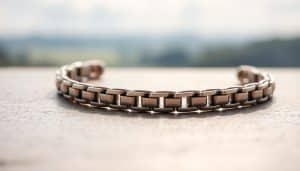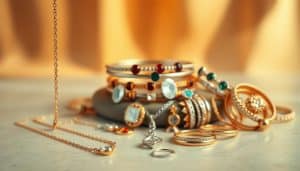10 Essential Tips on How to Clean Gold-Plated Jewelry for a Lasting Shine

10 Essential Tips on How to Clean Gold-Plated Jewelry for a Lasting Shine
Key Takeaways
- To maintain the gold plating and avoid premature tarnish or damage, choose non-abrasive, chemical-free options when learning how to clean gold-plated jewelry
- Keep gold-plated jewelry away from moisture and sweat and rough environments by taking it off before water-related activities or exercise.
- Use gentle cleaning methods like mild soap and soft brushes to delicately lift dirt without damaging fine details or the gold coating.
- To learn how to clean gold-plated jewelry, use mild soap, warm water, and a soft cloth to maintain the finish’s brightness without wearing it away. Rinse with water and dry, using a lint-free towel to avoid dulling and scratching.
- Keep it in a dry, airtight container and anti-tarnish materials to lessen contact with humidity and prevent scratches or tangling.
- To keep your gold-plated pieces looking their best, schedule professional cleanings every year or so and have them checked regularly.
To clean gold-plated jewelry, use mild soap, warm water, and a soft cloth to maintain the finish’s brightness without wearing it away. Rinse with water and dry, using a lint-free towel to avoid dulling and scratching.
Steering away from chemicals and strong cleaners preserves the plating. A cotton swab or soft toothbrush, quick and easy tools, access small details.
It lays out simple steps and safe, daily jewelry care tips.
1. Avoid Harsh Chemicals and Cleaners

To keep your gold-plated jewelry looking new, avoid harsh chemicals and cleaners. Substances like bleach and ammonia can damage the gold layer, causing discoloration or peeling. Even a small amount of bleach can dull its shine.
Many jewelry cleaners for solid gold or silver are too strong for gold-plated items and can wear away the plating faster than normal use. Abrasive cleaners and hard bristle brushes can scratch the surface, revealing the base metal underneath.
Instead, use mild, non-toxic cleaners like a mix of dish soap and warm water. Soak the jewelry for a few minutes and wipe it with a soft cloth to remove dirt safely. If you prefer a store-bought cleaner, choose one specifically formulated for gold-plated jewelry and avoid those with strong chemicals.
HonHo Jewelry Manufacturer recommends using lukewarm water and a soft microfiber cloth for their products to maintain their shine. Always check labels, as some cleaners may still contain damaging ingredients. By being cautious with your cleaning methods, you can help preserve the original beauty of your gold-plated jewelry.
2. Limit Exposure to Moisture and Sweat

To keep your gold-plated jewelry bright and durable, avoid exposing it to moisture and sweat. Remove your pieces before showering to prevent water and soap buildup, which can damage the gold plating.
Swimming in chlorinated or saltwater can also speed up corrosion, as chlorine and salt can dull the gold and reveal the base metal underneath. It’s best to store your jewelry in a dry place, like a jewelry box or a cloth bag, to prevent tarnish.
Wipe off any moisture immediately after sweating or washing your hands, using a soft, dry cloth to maintain the gold’s shine. A quick wipe after workouts or walks can significantly extend the life of your jewelry.
3. Avoid Wearing During Physical Activities

To keep gold-plated jewelry in good condition, avoid wearing it during physical activities. Sweat and friction from exercising can speed up tarnishing and wear away the plating. For example, wearing gold-plated chains or rings while jogging can leave dry spots on the jewelry.
Removing these pieces before working out reduces exposure to moisture and sweat, which can damage the plating. Even gentle activities like yoga can loosen clasps or cause jewelry to fall off. Sports and weightlifting can easily scratch rings and bracelets. To protect them, store jewelry in a soft pouch or box before exercising.
It’s also unwise to swim or shower with gold-plated jewelry, as chlorine and saltwater can harm the gold layer. Even tap water may dull the shine. Be sure to take off your jewelry before cleaning, as soaps can quickly wear down the plating.
Additionally, keeping jewelry away from direct sunlight and heat helps maintain its appearance, as fluctuations in temperature can cause the gold layer to flake. Proper storage in a lined case can extend the life of your gold-plated pieces, keeping them bright and beautiful for longer.
4. Clean with Mild Soap and Water Solution

A mild soap and water solution is a trusty method for cleaning gold-plated jewelry safely without dulling its sparkle. For maximum effectiveness, combine one cup of warm water with two or three drops of mild dishwashing liquid. Warm water aids in lifting oils and grime and the mild soap cleans without damaging thin gold plating. When your jewelry looks lackluster or feels tacky, this trick dissolves body oils and daily grime.
For instance, a stainless steel bracelet with gold plating from HonHo Jewelry Manufacturer (https://www.honhojewelry.com/) can benefit from this approach, keeping its finish bright and lasting.
For starters, soak gold-plated jewelry for 10 minutes. This step dissolves superficial grime and assists in loosening trapped detail work debris. Don’t overcrowd the bowl — only put one or two pieces in at a time, as touching pieces together can leave tiny scratches that dull the finish.
Soaking is mild enough for detailed items, like filigree earrings or engraved pendants. It does great on chains, charms and rings, letting the solution get into every nook and cranny without harsh scrubbing.
For deep cleaning, a cotton swab is your best friend when it comes to those hard to reach small spaces and grooves. Lightly roll the swab between fingers to direct it into dust and oil laden crevices. Soft-bristled toothbrushes do a good job with textured jewelry, particularly designs with raised or settings.
Light pressure is key — shoving will just rub off the gold layer. For instance, a cotton swab to clean the coq of an elaborate gold-plated chain, or a toothbrush to dislodge grime at the base of a stone.
Certain household cleaners such as toothpaste or baking soda may seem like a good idea but they’re actually too abrasive for gold-plated jewelry. These abrasives can wear off the thin layer of gold and scratch. Instead, stick with diluted dish soap to prevent damage.
Then, rinse each in warm water to wash off the soap. Rinsing avoids dullness and sticky spots.
Drying is easy, simply take the jewelry and gently pat it dry with a soft cloth. Polish with a microfiber cloth to bring back the shine and help avoid water spots. It’s crucial for keeping jewelry looking fresh after multiple washes.
5. Use a Jewelry Cleaning Brush Gently
Using a jewelry cleaning brush gently provides you with more control and keeps gold plated jewelry looking its best. Soft bristled brushes, such as baby or specialty jewelry brushes, work well. Their bristles wave around into little details and crevices, touching places cloths can’t get to. For instance, filigree rings or deeply grooved earrings can hide dirt in those hard to see places. A soft brush slides between these bits, pulling out gunk without scraping away the gold finish.
When cleaning, select a brush with soft, flexible bristles and ensure it’s clean. Even grains of sand caught in the bristles can scratch the delicate gold foil-painted layer. Most folks use a new, never-used soft bristled toothbrush, because they’re cheap and designed to be gentle. If you opt for a brush sold for jewelry, inspect its bristles for any sharp or stiff tips prior to each use. Slide your finger over the bristles and see if there are any rough patches that could harm your jewellery piece.
Just to ensure your gold-plated surface stays smooth and shiny, use light pressure when brushing. Hard scrubbing or pressing down risks rubbing off the thin gold coating, which can ruin the look of the jewelry. A light scrub, nothing abrasive, with just enough power to sweep dirt loose, will suffice. For stubborn gunk, dip the brush in a solution of gentle soap and lukewarm water.
It’s important to clean one piece at a time, so that you don’t knock jewelry together and cause scratches. For instance, when cleaning a tiny gold-plated pendant, brush around stones and inside settings with care, minding those tight angles where buildup lurks. This careful approach ensures that your favorite piece remains in pristine condition.
A jewelry cleaning brush, used gently, will maintain the shine and bright color that make gold-plated jewelry so tempting. It additionally assists in eliminating tarnish and layers of dull grime that settle down over time. Brushing too hard, or with a dirty brush, can destroy the thin gold layer, causing the jewelry to appear worn dramatically sooner. Regular, gentle cleaning maintains the longevity and brilliance of each gem, ensuring your jewelry pieces look their best for years to come.
6. Rinse with Warm Water After Cleaning

Rinsing gold-plated jewelry with warm water is essential for keeping it shiny and long-lasting. Warm water helps remove any leftover soap, which can dull the jewelry over time.
It’s best to use lukewarm water, as extreme temperatures can damage the gold plating. Rinse the jewelry gently under a light stream of water from the faucet to avoid knocking off stones or details.
For delicate pieces, like a gold-plated bracelet with charms, take extra care by rinsing each side slowly. Some people prefer using a small bowl of warm water for better control. HonHo Jewelry Manufacturer emphasizes thorough rinsing to prevent soap residue from dulling the shine, even on their tarnish-resistant pieces.
After rinsing, dry the jewelry with a soft, lint-free cloth to avoid scratches or water spots. Be gentle with intricate designs to prevent water from collecting in small crevices. This careful drying process helps maintain the jewelry’s sparkle.
7. Use a Soft Cloth for Polishing

A soft cloth is essential for polishing gold-plated jewelry and keeping it shiny. A microfiber cloth is best because it traps dust and dirt without scratching the delicate gold plating.
Rinse the jewelry with lukewarm water, then dry it with the cloth to remove oils and dirt. For example, tapping a gold-plated bracelet after wearing it can keep it from looking dull. Avoid rough fabrics like paper towels, as they can scratch the gold. Since gold plating is usually less than 1 micron thick, gentle care is important.
A specialized jewelry polishing cloth with fine fibers can enhance shine and is perfect for rings, earrings, and necklaces. Many jewelry stores sell these cloths, which can be reused. Regular polishing helps maintain the shine and prevents tarnish. Wiping down jewelry after each wear stops dirt from building up.
If the jewelry starts to fade, a light rub with a soft cloth can restore its finish. For deeper cleaning, mix one part water with vinegar, dip the cloth, wring it out, and polish gently.
Always let the jewelry air dry completely before storing it. For regular upkeep, a dry cloth is sufficient. Use short, soft strokes and avoid pressing too hard to protect the gold plating. This method helps keep the gold intact and preserves the piece’s beauty.
8. Store in a Dry, Airtight Container

To keep gold-plated jewelry shiny and free from tarnish, store it in a dry, airtight container. Moisture can cause tarnishing, so avoid places like bathroom shelves that are often humid. Instead, use a dry spot, like a dresser drawer, especially in humid areas.
Airtight containers, zip-lock bags, or specialized jewelry boxes can help keep out air and humidity, preventing oxidation and wear on the gold layer. Adding silica gel packets or anti-tarnish strips can further protect your jewelry from moisture.
It’s also important to store pieces separately to prevent scratches and tangles. Using individual bags or a jewelry box with compartments can keep items like delicate chains and rings safe from damage.
For extra protection, consider anti-tarnish bags or cloths that absorb moisture and neutralize harmful chemicals. These options are widely available and effective for both short and long-term storage.
9. Regularly Check for Wear and Tear

Regular checks for wear and tear are an easy way to keep gold-plated items in good condition. Early detection of issues like scratches or fading helps maintain a vibrant, smooth surface. For example, dull spots on a ring can indicate worn plating.
Inspecting jewelry closely can also reveal loose stones or weak clasps, which, if ignored, could lead to bigger problems. To check for wear, examine pieces under good light for dull areas or scratches and feel for sticky spots. Gold-plated items can gather dirt from sweat and lotions, especially those worn daily, like bracelets or watches.
If a chain feels sticky, clean it with warm, soapy water and a soft cloth to avoid damaging the gold coating. Addressing small issues quickly prevents them from becoming major problems. For daily-worn jewelry, check every one to two weeks; for less frequently worn pieces, once a month is enough.
Keep a record of inspections, and polish jewelry if it looks dull using lukewarm water and a soft cloth. For tougher grime, add gentle soap to the water. Always dry pieces completely before storing them in small boxes or soft pouches, away from moisture. Consistent maintenance and cleaning will help your gold-plated jewelry last longer and shine brighter.
10. Seek Professional Cleaning Annually

Regular professional cleaning keeps gold-plated jewelry looking shiny and fresh. It’s a good idea to visit a jeweler once a year, especially for items worn often or with intricate designs.
Daily wear can lead to grime and oils building up in small spaces, which a jeweler can clean effectively. For jewelry worn daily or for special occasions, consider cleaning every 6 to 8 months. During these visits, jewelers also inspect for loose stones or worn parts, catching potential issues early.
This is especially important for delicate pieces. Professional jewelers use gentle cleaning methods, avoiding harsh chemicals that can damage the plating.
Brands like HonHo Jewelry Manufacturer combine modern techniques with traditional craftsmanship for safe cleaning and care. If you don’t wear your jewelry often, cleaning it every 12 to 18 months may be enough.
Regular gentle at-home cleaning, paired with professional services, helps maintain both the shine and structure of your jewelry over time. For cherished pieces, occasional professional care is a worthwhile investment.
Conclusion
To maintain gold plated jewelry shiny and silky, apply basic care. Wash with mild soap and warm water. Dry with a soft cloth. Keep in a dry box or bag. Inspect clasps and links for minor fractures. Avoid abrasive chemicals.
Keep away from sweat and water for extended periods. A soft brush is great on little stains. To remove residue, rinse with water. Be careful not to wear pieces for sports or chores. If gold begins to fade, a jeweler can assist.
As for the pieces, have them cleaned once a year using pro tools. Tiny deeds maintain gold gleam bright. Want your pieces to last? Begin these habits today and pass along your advice to friends or family who swoon over jewelry.
Frequently Asked Questions
How often should I clean my gold-plated jewelry?
Clean your gold-plated jewelry every few weeks or whenever it begins to show visible tarnish. Routine, gentle cleaning methods maintain its luster and prevent accumulation from sweat, oils, and grime.
Can I use toothpaste to clean gold-plated jewelry?
No, not toothpaste. It’s abrasive and can discolor delicate plating. Instead, turn to a mild soap solution for proper care.
Is it safe to wear gold-plated jewelry every day?
Daily wear of gold-plated jewelry can accelerate wear and tarnishes. To maximize its durability, reduce everyday exposure to sweat, water, and harsh cleaning products.
What is the best way to dry gold-plated jewelry after cleaning?
Dry your jewelry pieces with a soft lint-free cloth to maintain their lustre. Avoid using paper towels or abrasive materials that can scratch and damage the surfaces.
Can I swim or shower with gold-plated jewelry?
No, just take it off before swimming or showering. Water, chlorine and soap can eat away at the gold and make it fade.
How do I store gold-plated jewelry to prevent tarnishing?
To maintain the glamour of your gold-plated jewelry, store it in a dry, air-tight container or a soft pouch, minimizing exposure to air and moisture for better durability.
When should I seek professional cleaning for gold-plated jewelry?
Take your gold-plated jewelry to a professional jeweller for thorough cleaning once annually, ensuring its durability and maintaining its luster and state.
Related Posts

10 Essential Tips on How to Clean Gold-Plated Jewelry for a Lasting Shine
Key Takeaways To clean gold-plated jewelry, use mild soap, warm water, and a soft cloth to maintain the finish’s brightness without wearing it away. Rinse




